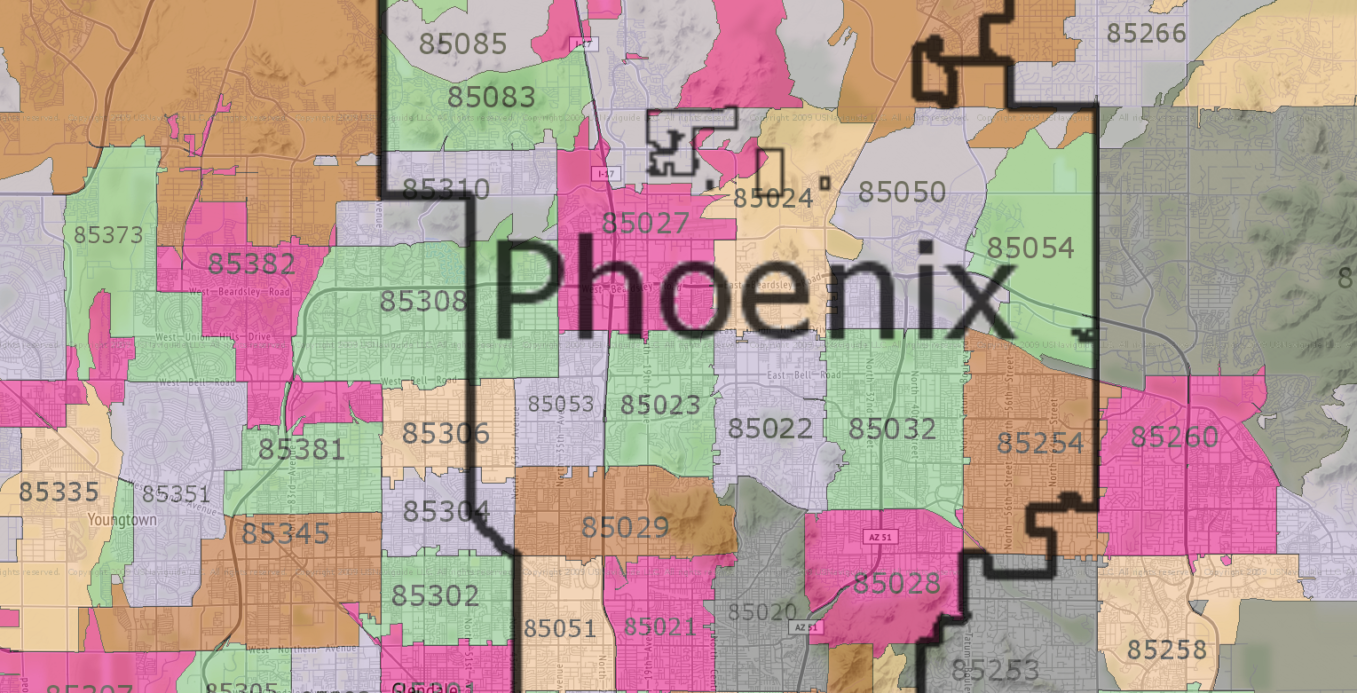

Places that fall completely or partially within the boundaries of the Phoenix–Mesa, AZ US are in bold below. The core part of the Phoenix Metropolitan Area is the Phoenix–Mesa, Arizona Urban Area, which is far smaller than the Metropolitan Statistical Area. For these reasons, much of the land that is part of the Metropolitan Statistical Area is rural or completely uninhabited. However, Arizona has relatively large counties and a harsh, rugged desert landscape.
#Phoenix zip code map 2018 plus#
The Office of Management and Budget defines a metropolitan area as the core city plus its county and any nearby counties that are economically dependent on the core city. What follows is a list of places in Metro Phoenix (populations for incorporated places are as of the 2020 census). In 2010 the median income for a household in the MSA was $50,385 and the median income for a family was $58,497. The racial makeup of the MSA was 73.0% White (58.7% White Non-Hispanic), 5.0% Black, 3.3% Asian, 2.4% Native American or Alaska Native (virtually all Native American) and 16.2% of other or mixed race. Percent of people living in poverty across Metro Phoenix the darker the red, the higher the concentration of poverty Īs of the 2010 census, there were 4,192,887 people, 1,537,137 households, and 1,024,971 families residing within the MSA. Oxnard-Thousand Oaks-Ventura, CA Metro Areaĭemographics Historical population Census Los Angeles-Long Beach-Anaheim, CA Metro Area Riverside-San Bernardino-Ontario, CA Metro Area San Diego-Chula Vista-Carlsbad, CA Metro Area Las Vegas-Henderson-Paradise, NV Metro Area Table of nearby metropolitan areas to the Phoenix-Mesa-Chandler, AZ Metro Area For instance, the closest metropolitan area with almost the same population size is the Riverside-San Bernardino-Ontario, CA Metro Area, which is 300 miles away. The Phoenix Metropolitan Area is hundreds of miles away from any other metropolitan area of similar population size. The total population for metropolitan Phoenix at the 2020 Census was 4,845,832. It is officially designated by the US Census Bureau as the Phoenix–Mesa–Chandler, AZ Metropolitan Statistical Area. The Phoenix Metropolitan Area comprises Maricopa County (2020 population: 4,420,568) and Pinal County (2020 population: 425,264). This includes the Phoenix Metropolitan Area and the Payson, AZ Micropolitan Statistical Area.Īs of April 1, 2020, the Phoenix-Mesa CSA had a population of 4,899,104, making it the fourteenth-most populous in the nation.

Office of Management and Budget (OMB) and by the Census Bureau which consists of the entirety of the counties of Maricopa, Pinal and Gila. The Phoenix-Mesa Combined statistical area (CSA) was designated in September 2018 by U.S. Water insecurity and drought in conjunction with climate change have become a significant concern for the metropolitan area's future growth prospects. The 2000 census reported the population of the metropolitan area to be 3,251,876. rate of 13.2%, helping make Arizona the second-fastest growing state in the nation in the 1990s behind Nevada. The population of the Phoenix Metropolitan Area increased by 45.3% from 1990 through 2000, compared to the overall U.S. This also contributed to the entire state's exceptional growth the area is home to just over two-thirds of Arizona's population. Metro Phoenix grew by 652,945 people from April 2010 to April 2020, making it one of the fastest growing metro areas in the country. The gross domestic product of the Phoenix Metropolitan Area was $255 billion in 2018, 16th-largest amongst metro areas in the United States.Īs of the 2020 census, the two-county metropolitan area had 4,845,832 residents, making it the 11th-largest metropolitan area in the nation by population. It anchors the Arizona Sun Corridor megaregion along with the second-most populous metropolitan area in the state, the Tucson metropolitan area. The United States Office of Management and Budget designates the area as the Phoenix-Mesa-Chandler Metropolitan Statistical Area (MSA), defining it as Maricopa and Pinal counties. The Phoenix Metropolitan Area, also known as the Valley of the Sun, the Salt River Valley, Metro Phoenix, or The Valley, is the largest metropolitan statistical area in the Southwestern United States, centered on the city of Phoenix, that includes much of central Arizona.


 0 kommentar(er)
0 kommentar(er)
